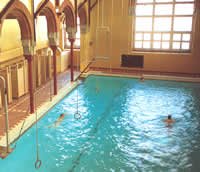Is Swimming Worth the Effort?
Short answer: Yes.
Swimming is one of the best workouts you can do. Ironically, the worse swimmer you are, the more effort, and the better the exercise!
From 2005 to 2010 I taught aqua aerobics in all nine of the Edinburgh Leisure pools. Water-based exercise is a fabulous low-impact cardio workout that is especially good for those with lower limb (leg) injuries. Because you are buoyant in the water, you can achieve a whole body workout without compromising existing knee, foot or ankle injuries. It’s great also for those with mobility issues - I taught an aqua class where the participants would leave a pile of walking sticks and crutches by the pool, as in the pool they could move freely. What a joy!
Swimming is a good all-round activity because it:
Gets your heart rate up without putting impact through the body.
Builds strength, especially upper body strength as your swimming improves.
Builds endurance, especially if swimming lengths.
Focuses the breathing, and improves lung function.
Is a complete change of scene, and can help alleviate stress levels.
pic: Drumsheugh Swimming Bath
The more you swim, the easier it gets. The routine around swimming also gets easier as you get in the habit.
For your first swim, use this checklist:
Check your swimsuit. Does it still fit? Check it’s not perished! This can happen. If you need a new swimsuit, aim for good coverage and sturdy straps. Speedo is the ‘go to’ brand.
Find a time in your diary you can take a good 1.5 hours. You don’t want to be rushed the first time you’re figuring out a new pool.
Check the pool timetable that lanes are available for public swimming. You might also like to phone and chat to the receptionist - can you just drop-in, or do you need to book? Do the lockers take a pound coin? What’s the best time to come for an informal swim?
When you’ve worked out your first swim time, pack a bag. Plastic carrier bags inside a backpack (that can be hung on a changing room hook) is how I pack. One plastic bag for clothes, one for swimsuit and towel. Remember goggles if you use them, a pound coin for the locker if required, flip flops if the floors make you squeamish, toiletries, water bottle (swimming is thirsty work) and a post-swim snack.
If you’ve not swum for a while, congratulate yourself as you enter the water. You’ve done the hard bit. The worst thing about getting swimming again is all the faff in getting to the pool.
Enjoy your first swim, aim for about a quarter distance of what you regularly swim. Best to do less, enjoy it and recover well. Next time you swim, build up further.
Build up slowly - the longer break you’ve had from swimming, the more gradual increase in distance.
Look forward to your swim, perhaps weekly, as alternative exercise and a good stress release. Plan around it. Friday mornings are my personal swim time.
I had always wanted to try a triathlon, so I taught myself how to be a better swimmer using Terry Laughlin’s Total Immersion book. If you can refine your swim technique to reach further with each stroke, you will complete a length with much less effort. I’m pleased I did compete in the Balerno Ladies Triathlon back in 2006. It was a great experience that has helped me greatly as a trainer. Swimming uses many different muscles and I have put together specific swim strength dumbbell programmes for many clients.
If you’re looking at improving your swimming strength and endurance, or entering a triathlon, drop me a line and I can help you. I can also advise in appropriate and effective water-based exercise and have first-hand experience of all the pools in Edinburgh.

